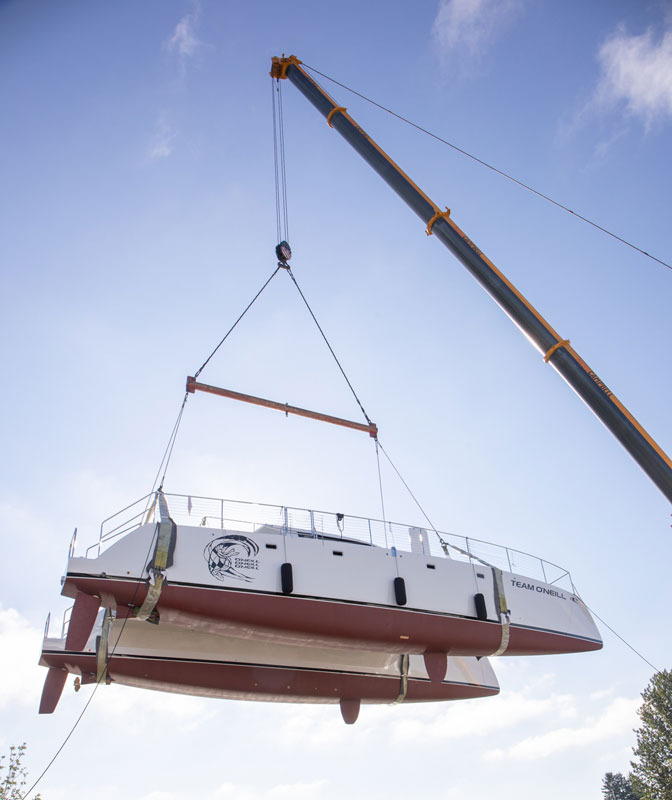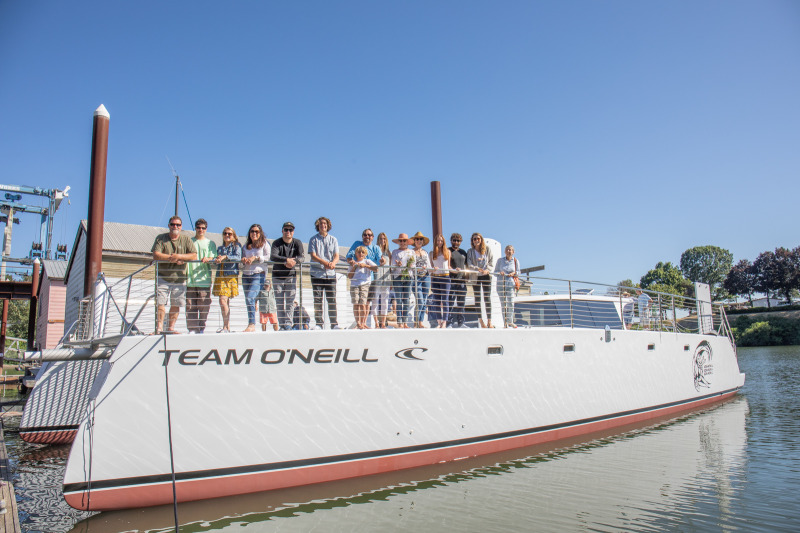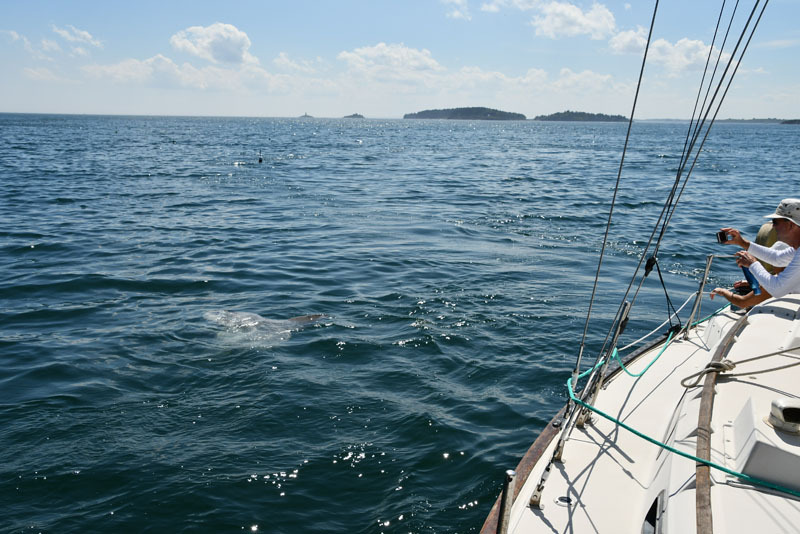
A Thoroughly West Coast Cat
There was a big splash in the Pacific Northwest at the end of July, as the new 65-ft O’Neill Sea Odyssey catamaran was launched at Schooner Creek Boat Works.

This is a thoroughly West Coast cat — she was drawn by the Newport Beach-based Morrelli & Melvin Design, built at Schooner Creek in Portland, Oregon (a yard that we featured in our West Coast Boat Builders series), and the boat will explore the waters of Monterey Bay. In 1996, wetsuit pioneer Jack O’Neill started a marine education program for school kids and community groups based out of Santa Cruz. In its 22 years, the O’Neill Sea Odyssey has gotten over 100,000 kids onto the water and has been a strong advocate for ocean conservation. Jack O’Neill — who passed away last year at the age of 92 — called the Sea Odyssey his "greatest accomplishment."

In 2015, Schooner Creek founder Steve Rander sold the company to Kevin and Shauna Flanigan — this is the first cat launched under their ownership, and there are plenty more to come, including a new boat for Adventure Cat Sailing Charters here in the Bay Area. "We are excited to be part of such a great project, helping teach the public how to respect the oceans," a Schooner Creek press release said. "We also want to thank the O’Neills for having us build this amazing boat."

We look forward to seeing the new O’Neill catamaran loaded with kids and cruising Monterey Bay.
Ocean Sunfish Oddities
It’s always a bit strange when you cross tacks with an ocean sunfish. They look like the most uncoordinated klutzes in the seas, and the first glimpse of a large fin makes one think of a whale or shark. But as a slow-motion convergence unfolds, their inability to move out of the way reveals a clumsy fish, making you wonder why the species hasn’t succumbed to the Darwin awards. We recently had this experience while sailing near shore on the coast of Maine.

©2018 Latitude 38 Media, LLC
On a sunny afternoon sail in about 80 feet of water in Harpswell Sound, Maine, a fin popped up in front of us but never moved. We quickly passed what must be the slowest moving fish in the sea. Ocean sunfish are typically found in temperate waters and can grow to 2,000 pounds on a primarily jellyfish diet. Given their ability to swim, the jellyfish is the perfect prey.

©2018 Latitude 38 Media, LLC
Despite their apparent poor swimming abilities, they are known to dive to depths of 2,000 feet, can propel themselves at up to two miles per hour, and can cover 16 miles in a day. Amazingly, they have also been known to leap out of the water when being pursued by a predator. What might have outfoxed evolution is the fact that female ocean sunfish produce more eggs than any other known vertebrates, and can release up to 300,000,000 eggs at a time! All those eggs must be to help compensate for the difficult-to-envision role of the male ocean sunfish.

©2018 Latitude 38 Media, LLC
When mid-ocean, they’re a friendly neighbor and appear to be one of the most relaxed and contented fish in the sea. When we ran into one, we were sailing along at a leisurely four knots so only about twice the speed of an ocean sunfish at full throttle. We made a couple of passes to say hello as the sunfish gave a wink and hoped another jellyfish would drift in front of its waiting mouth.
Harming or Helping the Delta?
In July, the California Department of Water Resources sent out the following press release:
"The California Department of Water Resources (DWR) today released a Draft
Supplemental Environmental Impact Report/Environmental Impact Statement (EIR/EIS) for California WaterFix. The document analyzes several proposed changes designed to reduce the project’s footprint and costs, and minimize impacts on environmental resources in the Sacramento-San Joaquin Delta (Delta), including wetlands and other water resources.
"Public comment will be accepted through Sept. 17, 2018. DWR will respond to all substantive comments received on the Draft Supplemental EIR/EIS and consider them in the decision-making process.
"The proposed modifications analyzed in the environmental document released today have not changed the impact conclusions for any resource areas. The modifications include:
"Changing the locations of reusable tunnel material storage sites near the intermediate forebay, on Zacharias Island, on Bouldin Island, and near the relocated Byron Tract Forebay. Relocating the tunnel boring machine (TBM) launch shaft and barge landing location on Bouldin Island. Creating a new Byron Tract Forebay (eliminating the extensive modifications to Clifton Court Forebay) and relocating the consolidated pumping plant. Realigning the 40-foot diameter tunnels slightly to accommodate the relocated Bouldin Island TBM launch shaft and Byron Tract Forebay consolidated pumping plant relocation. Relocating or eliminating appurtenant facilities such as barge landing sites, concrete batch plants, and construction access roads to improve facility design. Realigning the 40-foot diameter tunnels to avoid the town of Hood and municipal water wells.
"DWR released the Draft Supplemental EIR/EIS as the lead state agency in compliance with the requirements of the California Environmental Quality Act. As the federal lead agency, the U.S. Bureau of Reclamation will release the Draft Supplemental EIR/EIS separately for public review in compliance with the National Environmental Policy Act.
"To access the public review draft and associated environmental documents, please visit:
https://californiawaterfix.com/resources/draft-supplemental-environmental-impact-report-environmental-impact-statement-eir-eis."

© Latitude 38 Media, LLC
Bill Wells, executive director of the Delta Chambers of Commerce & Visitors Bureau, just about flipped his lid when he read this. (Bill also writes the Delta Rat column for Bay & Delta Yachtsman and has been a supporter of Latitude 38’s Delta Doo Dah cruising rally for many years.) "This is more like a state plan to further damage Delta businesses," he wrote. "These people have no idea what they are doing. Their plan for Bouldin Island (owned by Metropolitan Water District) will destroy Tower Park Resort by dumping thousands of tons of chemical-laced mud on the island just across Little Potato Slough from Tower Park and its outdoor restaurant. The stench when it is wet will be unbearable, and when it dries the dust sent by the prevailing wind will cover the resort."

© Latitude 38 Media, LLC
Tower Park is a valuable resource to locals and visitors, by land and water, not to mention all the people it employs. "I was outraged when I heard this," adds Bill. "The owners have just put millions into Tower Park. They even have outdoor seating in the restaurant facing toward Bouldin Island." Bouldin Island is currently planted with corn and alfalfa. Hwy. 12, the east-west artery of the Delta, runs through it. The South Fork of the Mokelumne River borders its north shore, and Potato Slough, which is very popular with sailors, runs along its south shore.

© Latitude 38 Media, LLC
The folks from North Delta CARES had a display at the recent Courtland Pear Fair. According to the graphics, Courtland and Hood, on the east side of the Sacramento River, are ground zero for Tunnels intake construction, and Clarksburg, on the west side, faces another intake construction site. These are all charming but small communities worth defending.


We invite substantive comments from both sides of this controversy.
Randall Reeves and the OCC at AI
On Saturday the 11th, the Ocean Cruising Club will be hosting a potluck picnic at Angel Island between 11 a.m. and 4 p.m. The event, held at Ayala Cove, Picnic Area B, will be hosted by Rick Whiting, the regional rear commodore for the OCC, and will feature Randall Reeves — who’s fresh off a solo circumnavigation — and his 41-ft sloop Moli.

"The OCC is a worldwide organization with port captains in even the most out-of-the-way places," Reeves told us. "It’s the only club I’ve ever belonged to and it essentially saved my bacon when Mo and I were forced to make our two unscheduled stops. The OCC port captains met me at the dock in both Ushuaia, Argentina, and Hobart, Tasmania, and were instrumental in making my stays there a success. The club is open to any cruisers who’ve completed a 1000-mile ocean passage and is a super value." Tony Gooch, Moli’s previous owner who’s also done a singlehanded circumnavigation, will be at the event as well.
You can, of course, sail or ferry into Ayala Cove on Angel Island. Please bring food and drink. A grill, paper plates, napkins, cups and utensils will be provided. Reeves asks that you please consider making a donation of $20 to cover costs.
If you’re ferrying from Tiburon, the schedule can be found here. If you’re bringing your own boat, there are (of course) 19 day-use slips for a $15 fee, as well as 27 mooring buoys in Ayala Cove that can be used overnight for a $30 fee.
